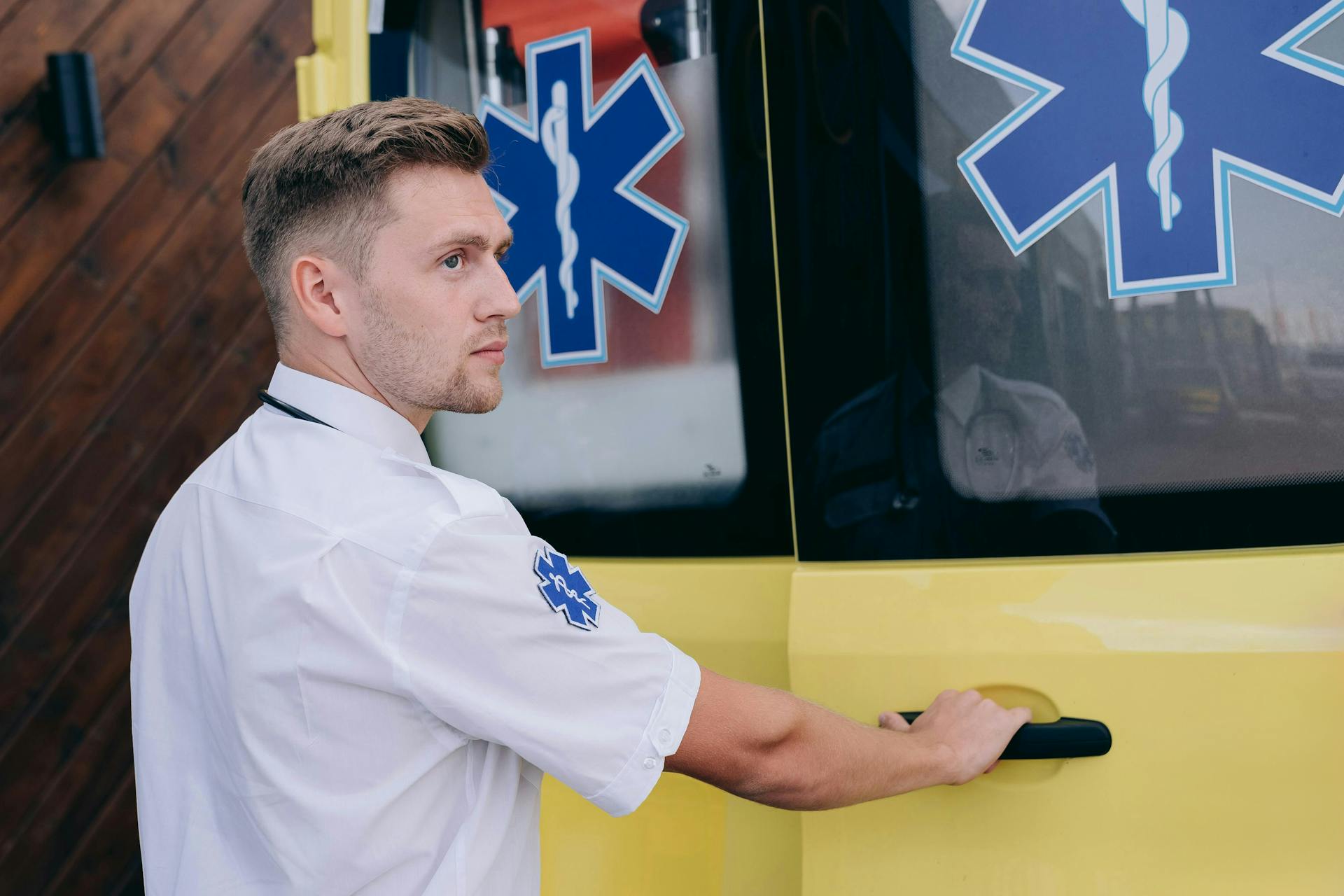
Insurance coverage for ambulance costs can be a lifesaver, but it's essential to understand what's covered and what's not. In most states, ambulance services are considered emergency medical transportation, which is typically covered by health insurance.
The cost of an ambulance ride can be steep, ranging from $1,000 to $2,000 or more, depending on the location and services required. However, with the right insurance coverage, you may be able to reduce or even eliminate these costs.
If you have a health insurance plan, it's crucial to check your policy to see if ambulance services are included. Some plans may have specific requirements or limitations for coverage, such as needing to be transported to a hospital or having a certain level of medical necessity.
Intriguing read: Medical Expense Insurance Would Cover
Cost and Coverage
The cost of an ambulance ride can be a significant financial burden, but the good news is that many health insurance plans offer coverage to varying degrees. On average, an ambulance ride in the United States can range from $300 to over $2,500.
In some cases, health insurance may not cover the full cost of an ambulance ride, especially if the ambulance service is out-of-network or the ride is deemed not medically necessary. According to an analysis by the Kaiser Family Foundation, half of ambulance rides in Florida result in an out-of-network charge for those with private health insurance.
The factors that influence the cost of an ambulance ride include the distance traveled, the level of medical care provided during transport, and the use of specialized equipment. The type of ambulance used, such as basic life support (BLS) or advanced life support (ALS), can also impact costs.
Here are some examples of ambulance ride costs in different locations:
- California: $589
- Irving, Texas: $750 (basic life support, plus a 30% markup of all consumables used, $15 per mile, and a $5 technology fee)
Keep in mind that these costs are just estimates, and the actual cost of an ambulance ride can vary significantly depending on the specific circumstances.
Factors Affecting Ambulance Rides
Ambulance rides can be expensive, and understanding the factors that affect the cost can help you prepare for an emergency. The cost of an ambulance ride without insurance can vary significantly, typically ranging from a few hundred to several thousand dollars.
Several factors can impact your bill, including the location where you require the service, the distance of the trip, and the type of transport used. Ambulance costs can differ significantly from region to region, due to variations in healthcare pricing and local economic factors.
The farther the transportation, the higher the cost. This is because many ambulance services charge based on the distance traveled. A ground ambulance is generally more cost-effective than an air ambulance, which can be considerably more expensive, often reaching tens of thousands of dollars.
You may also be charged for any medical care provided during the ambulance ride, including the cost of medical supplies, medications, and any specialized equipment used. If your condition requires specialized medical services such as advanced life support during ambulance transport, the cost may increase.
Here are some key factors that can affect the cost of an ambulance ride:
- Location: Ambulance costs can differ significantly from region to region.
- Trip Distance: The farther the transportation, the higher the cost.
- Transport Type: Ground ambulances are generally more cost-effective than air ambulances.
- Treatment on the Trip: You may be charged for any medical care provided during the ambulance ride.
- Specialized Services: The cost may increase if your condition requires specialized medical services.
Car Coverage
Auto insurance is usually your best option when your ambulance trip is due to a car accident. You won't have to pay a deductible or copay.

Both medical payments coverage and personal injury protection (PIP) can pay for your and your passengers' ambulance services if you're in an accident. They can also help if a car hits you as a pedestrian.
However, there are some limitations. Most importantly, auto insurance only covers ambulance services when they're "medically necessary."
You can get coverage for healthcare costs due to a car accident through medical payments coverage or PIP. They're optional in most states, so don't assume you already have them.
Here are some key points to remember about car coverage for ambulance rides:
- Auto insurance may cover your deductible or copay for your health policy if you need to use both.
- Medical payments coverage and PIP can pay for ambulance services if you're in an accident.
- Auto insurance only covers ambulance services when they're "medically necessary."
Insurance Coverage
Insurance coverage for ambulance rides can be complex, but understanding the basics can help you navigate the process. Most health insurance plans cover emergency ambulance services, but the extent of coverage varies based on your insurance plan, network restrictions, and the nature of the emergency.
If you're in a medical emergency, your health insurance policy likely covers ambulance transportation. However, you may still need to pay a deductible, co-insurance, and copayment. The No Surprises Act mandates that emergency air ambulance services must be billed at in-network rates, but this law doesn't apply to ground ambulance rides.
Curious to learn more? Check out: Bcbs Emergency Room Coverage
Medicaid covers ambulance rides for emergencies without cost-sharing for beneficiaries. However, coverage and potential cost-sharing requirements can vary by state. If you're a Medicare beneficiary, your Part B coverage includes ground and air ambulance rides in emergencies, with limited coverage for nonemergency transports.
Auto insurance is usually your best option when your ambulance trip is due to a car accident. Your auto insurance may cover your deductible or copay for your health policy if you need to use both. Medical payments coverage or personal injury protection (PIP) can pay for ambulance services if you're in an accident, but they're optional in most states.
Here are some key factors to consider when determining insurance coverage for ambulance rides:
- The severity of your injuries: Health and personal injury protection (PIP) insurance plans will only cover ambulance rides deemed "medically necessary."
- Whether or not the ambulance company has a contract with your insurer: If your insurance company has a contract with the ambulance company, it's in-network and you'll still need to pay copays and deductibles.
It's essential to review your insurance policies and understand the terms and conditions related to ambulance coverage. You can also try to negotiate with your insurer and ambulance company if you're facing unexpected costs.
Additional Costs and Protections
You might be surprised to learn that insurance coverage for ambulance rides can vary widely depending on the state you live in. Some states have laws protecting consumers from surprise medical bills, but others don't.
Fourteen states in the United States have enacted laws to protect consumers from balance billing by ground ambulance providers. These laws vary in their approaches to safeguarding consumers, from setting rates for out-of-network ground ambulance payments to explicitly prohibiting ground ambulance balance billing.
In California, for example, out-of-network fees are regulated, and consumers are protected from excess charges. Ground ambulance providers cannot bill uninsured or self-pay patients more than the established payment by Medi-Cal or Medicare fee-for-service amount, whichever is greater.
If you're taking an ambulance ride as part of a non-emergency situation, it's a good idea to ask the provider whether they're in your network. If not, try to secure a different ambulance or alternative transportation.
Here's a breakdown of some of the states with laws protecting consumers from surprise ambulance bills:
In some states, like Texas, the law only applies to public providers, while in others, like California, it applies to both public and private providers.
What to Do If Not Covered
If your insurance doesn't cover an ambulance ride, it's essential to understand the reasons behind the denial. Carefully review the denial notice provided by your insurance company to understand the specific reasons for the denial.
You may have been denied coverage due to lack of medical necessity, improper documentation, or noncompliance with policy terms. Reach out to the health care provider or ambulance service that transported you to verify if they submitted all necessary documentation and billing information to your insurer.
If the denial remains unresolved, file an appeal with your insurance company. Follow your insurer's appeal process, which often involves submitting additional medical records, supporting documents, or a written statement from your health care provider explaining the necessity of the ambulance ride.
Intriguing read: Will Insurance Cover Urgent Care
You can also seek input from your health care provider who recommended the ambulance service. Gather any supporting documentation and keep track of your appeal's progress, ensuring the insurer meets specified deadlines.
If your initial appeal is denied, consider filing another appeal, potentially seeking a third-party review. Consult your insurance company to understand how to request an external review of your claim denial.
Here are the steps to appeal a denied ambulance claim:
1. Review the denial notice and understand the reasons for the denial.
2. Reach out to the health care provider or ambulance service to verify documentation.
3. File an appeal with your insurance company.
4. Seek input from your health care provider and gather supporting documentation.
5. Keep track of your appeal's progress and ensure the insurer meets deadlines.
6. Consider filing another appeal or seeking a third-party review if the initial appeal is denied.
Remember to maintain records of all communications, including emails, letters, and phone calls, with your insurance company, health care provider, and any external parties involved. These records may come in handy as you work on your appeal and involve other organizations.
A fresh viewpoint: Does Blue Cross Insurance Cover Urgent Care
Frequently Asked Questions
Does medical insurance cover 9-1-1 calls?
Medical insurance may cover 9-1-1 calls in emergency situations, with no out-of-pocket expenses for patients with Medicaid or Medicare coverage
Sources
- https://www.ci.lake-city.mn.us/index.asp
- https://www.knellerins.com/blog/does-health-insurance-cover-ambulance-charges-exploring-the-factors-and-options
- https://www.moneygeek.com/insurance/health/health-insurance-cover-ambulance-rides/
- https://www.thebalancemoney.com/does-insurance-cover-ambulance-services-5208416
- https://www.chaliklaw.com/faqs/are-ambulance-rides-covered-by-insurance/
Featured Images: pexels.com


